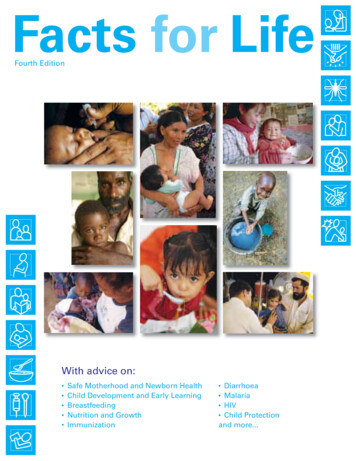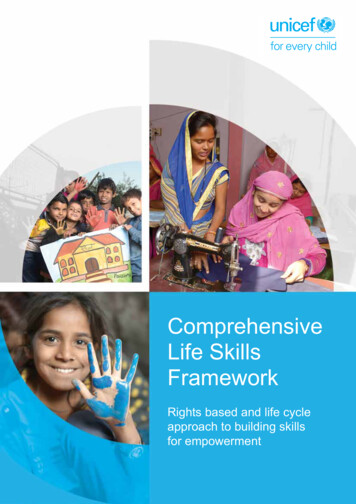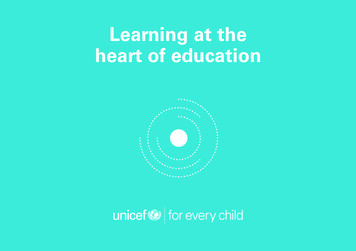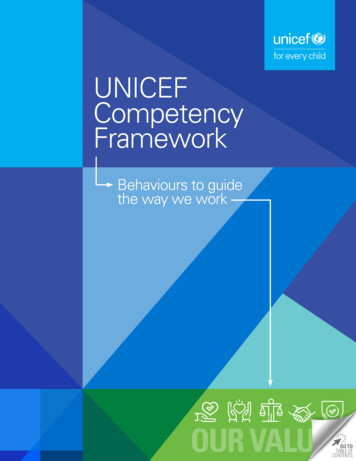
Transcription
Facts for LifeFourth EditionWith advice on: Safe Motherhood and Newborn HealthChild Development and Early LearningBreastfeedingNutrition and GrowthImmunizationDiarrhoea Malaria HIV Child Protectionand more.
Produced by UNICEF, WHO, UNESCO, UNFPA, UNDP, UNAIDS, WFP and the World Bank,Facts for Life can be found at www.factsforlifeglobal.org. The website will be updatedregularly and links to an interactive site for posting comments, sharing experiences andmaterials and discussions on relevant issues.First edition published in 1989 by UNICEF, WHO and UNESCO.Second edition published in 1993 by UNICEF, WHO, UNESCO and UNFPA.Third edition published in 2002 by UNICEF, WHO, UNESCO, UNFPA, UNDP, UNAIDS, WFP andthe World Bank.Fourth edition published in 2010 by UNICEF, WHO, UNESCO, UNFPA, UNDP, UNAIDS, WFPand the World Bank.Cover photo credits (from left to right): UNICEF/NYHQ2006-0081/Noorani UNICEF/NYHQ2006-2405/Markisz UNICEF/NYHQ2009-0716/Nesbitt UNICEF/NYHQ2004-1260/Pirozzi UNICEF/NYHQ2008-1512/Holtz UNICEF/NYHQ1993–0112/LeMoyne UNICEF/NYHQ2008-1279/Estey UNICEF/NYHQ2009-0690/Ramoneda United Nations Children’s Fund, New York, 2010This publication may be reproduced for educational or non-profit purposes withoutpermission from the copyright holder, providing acknowledgement of the source is made.UNICEF would appreciate receiving a copy of any publication that uses FFL as a source.Permission in writing is required to use FFL for any commercial purposes.For permission, please contact:UNICEF Division of Communication, Permissions3 UN Plaza, NY, NY 10017, USAEmail: nyhqdoc.permit@unicef.orgISBN: 978-92-806-4466-1Sales number: No.: E.09.XX.24Price: 15.00United Nations Children’s Fund3 United Nations PlazaNew York, NY 10017, USAwww.unicef.orgFor any queries, please email ffl@unicef.org
stcaFrofefiLnoitidEFourth
LiferofsFactSTNEONTCForeword . . . . . . . . . . . . . . . . . . . . . . . . . . . . . . . . . . . . . . . . . . . . . . . . . . . . . . . ivPurpose . . . . . . . . . . . . . . . . . . . . . . . . . . . . . . . . . . . . . . . . . . . . . . . . . . . . . . . . viStructure . . . . . . . . . . . . . . . . . . . . . . . . . . . . . . . . . . . . . . . . . . . . . . . . . . . . . . . viiEssential Messages . . . . . . . . . . . . . . . . . . . . . . . . . . . . . . . . . . . . . . . . . . . . . . viiiGuide for Using Facts for Life . . . . . . . . . . . . . . . . . . . . . . . . . . . . . . . . . . . . . . . xGlossary . . . . . . . . . . . . . . . . . . . . . . . . . . . . . . . . . . . . . . . . . . . . . . . . . . . . . . . 194The topics:Diarrhoea . . . . . . . 89ii Facts for LifeCoughs, Coldsand More SeriousIllnesses . . . . . . . .101Timing Births . . . . . 1Safe Motherhoodand NewbornHealth . . . . . . . . . .11Hygiene. . . . . . . . 109Malaria . . . . . . . . 121
Child Developmentand EarlyLearning . . . . . . . . 29Breastfeeding . . . . 47Nutritionand Growth . . . . . 61Immunization . . . . 77HIV . . . . . . . . . . . 129ChildProtection . . . . . . 149InjuryPrevention . . . . . 163Emergencies:Preparedness andResponse . . . . . . 179Facts for Life iii
LiferofsFactDROWOREFNearly 9 million children died in 2008 from preventable illnesses before reaching their fifthbirthday – more than two thirds of them during the first year of life. Millions more surviveonly to face diminished lives, unable to develop to their full potential.Five diseases – pneumonia, diarrhoea, malaria, measles and AIDS – together account forhalf of all deaths of children under 5 years old. Undernutrition is a contributing cause ofmore than one third of these deaths.It is possible to save lives and greatly reduce human suffering by expanding low-costprevention, treatment and protection measures. The challenge is to ensure that thisknowledge is shared with parents, caregivers and communities, who are the first line ofdefence in protecting children from illness and harm.Facts for Life has been developed as a vital resource for those who need it most. It deliversessential information on how to prevent child and maternal deaths, diseases, injuriesand violence.Since Facts for Life was first released in 1989, countless families and communities aroundthe world have put its messages and guidance into practice. These efforts over theyears have contributed significantly to progress on key global indicators such as health,education, life expectancy, and infant and maternal morbidity and mortality. Much can beachieved by empowering families and communities to adopt behaviours that improve childsurvival, growth, learning, development and protection, while also promoting children’s andwomen’s rights.The fourth edition of Facts for Life expands on previous editions and contains severalsignificant changes. For example, because of the inextricable link between the health ofthe mother and the health of the child, a Newborn Health section has been included in theSafe Motherhood chapter.A chapter on Child Protection has also been added, which focuses on the vulnerabilities ofchildren and the actions needed to ensure that they grow up in supportive environments inthe home, school and community.iv Facts for Life
Facts for Life provides information to help save, improve and protect children’s lives, andshould be shared widely with families, health workers, teachers, youth groups, women’sgroups, community organizations, government officials, employers, trade unions, media,and non-governmental and faith-based organizations.Facts for Life is designed to educate those who have influence over the safety and wellbeing of children. Through simple messages, it aims to bring life-saving knowledge to everycorner of the world.Ann VenemanMargaret ChanExecutive DirectorUnited Nations Children’s FundDirector-GeneralWorld Health OrganizationKoïchiro MatsuuraThoraya Ahmed ObaidDirector-GeneralUnited Nations Educational, Scientific and CulturalOrganizationExecutive DirectorUnited Nations Population FundHelen ClarkMichel SidibéAdministratorUnited Nations Development ProgrammeExecutive DirectorJoint United Nations Programme on HIV/AIDSJosette SheeranGraeme WheelerExecutive DirectorWorld Food ProgrammeManaging DirectorThe World BankFacts for Life v
osepruPheTSTCAFofEFILFORFacts for Life aims to provide families and communities with the information they need tosave and improve the lives of children. Parents, grandparents, other caregivers and youngpeople can refer to this practical source of information for answers to their questions relatedto childbearing and getting children off to the best start in life. The challenge is to ensure thateveryone knows and understands these facts and is motivated to put them into practice.The messages contained in Facts for Life are based on the latest scientific findings bymedical and child development experts around the world. These facts are presented insimple language so they can be understood and acted upon easily by people without ascientific background. Doing so can save lives.The Facts for Life messages are also based on human rights, particularly the Convention onthe Rights of the Child and the Convention on the Elimination of All Forms of Discriminationagainst Women.The messages empower people to fulfil the rights of their children. They also are aimedat enabling women, young people and children to exercise and speak out in favour oftheir rights.Everyone can help communicate the Facts for Life messages — health workers, teachers,social workers, government officials, broadcasters, journalists, community workers,religious and political leaders, mothers, fathers, grandparents, other family members,friends, neighbours, students and people in all walks of life — young and old, men andwomen, and girls and boys.vi Facts for Life
oferutcuhe StrTSTCAFEFILFORFacts for Life consists of 14 chapters filled with practical information about how to ensurechildren’s rights to survival, growth, development and well-being. The topics addresspregnancy, childbirth, major childhood illnesses, child development, early learning,parenting, protection, and care and support of children.Each chapter has three parts: an introduction, key messages and supporting information.THE INTRODUCTION is a brief ‘call to action’. It summarizes the extent of the problem andthe importance of taking action. The introduction aims to inspire people to get involvedand share this information widely. It can be used to motivate political leaders and themass media.THE KEY MESSAGES, addressed to parents and other caregivers, are the essence ofFacts for Life. They contain the essential information that people need to protect theirchildren. The key messages are clear, brief and practical, so people can easily understandthem and take the recommended action. These messages are meant to be communicatedoften and in various ways through multiple channels of communication.THE SUPPORTING INFORMATION elaborates on each key message, providing additionaldetails and advice. This information is particularly useful for community-based workers,health workers, social workers, teachers and families – anyone who wants to know moreabout the survival, growth, development and protection of infants and children. It can beused to answer questions from parents and other caregivers.Facts for Life vii
ifes for LFactSEGESSAMLAIENTESS1.The health of women1 and children can be significantly improved when births arespaced at least two years between the birth of the last child and the beginning of thenext pregnancy. Health risks increase for both the mother and the child when pregnancyoccurs before age 18 or after age 35. Both men and women, including adolescents,need to know about the health benefits of family planning so they can makeinformed choices.2.All pregnant women should visit a trained health worker for prenatal and post-natalcare, and all births should be assisted by a skilled birth attendant. All pregnant womenand their families need to know the warning signs of problems during and afterpregnancy and the options for seeking assistance. They also need to have plans andresources for obtaining skilled care for the birth and immediate help if problems arise.3.Children learn from the moment of birth. They grow and learn best when they receiveattention, affection and stimulation, in addition to good nutrition and proper health care.Encouraging girls and boys equally to observe and express themselves and to play andexplore helps them learn and develop socially, physically, emotionally and intellectually.4.Breastmilk alone is the best food and drink for an infant for the first six months of life.After six months, infants need other nutritious foods, in addition to breastfeeding up totwo years and beyond, to meet their growth and development needs.5.Poor nutrition during the mother’s pregnancy or the child’s first two years can slow achild’s mental and physical development for life. Children need a well-balanced diet thatincludes protein and energy foods as well as vitamins and minerals, such as iron andvitamin A, to ensure good health and development. From birth to age 1, children shouldbe weighed every month and from age 1 to age 2, at least every three months. If a childdoes not appear to be growing, the child should be seen by a trained health worker.6.Every child should complete the recommended series of immunizations. Immunizationsduring a child’s first year of life and into the second year are especially important forearly protection against diseases that can cause poor growth, disability or death. Allwomen of childbearing age, including adolescent girls, need to be protected againsttetanus for their own benefit and for their future babies. Over time, five doses of tetanusvaccine are recommended for lifelong protection. A booster should be given duringpregnancy if the woman has not yet received five doses.7.A child with diarrhoea needs plenty of the right liquids — breastmilk and ORS (oralrehydration salts) solution – and, if older than 6 months, other nutritious liquids andfoods should be added. Zinc should be given to reduce the severity of the diarrhoea.1Throughout this publication, references to pregnant women include pregnant adolescents.viii Facts for Life
If the diarrhoea is mixed with blood or is frequent and watery, the child is in danger andshould be taken to a trained health worker for immediate treatment.8.Most children with coughs or colds will get better on their own. But if a child with acough and fever is breathing rapidly or with difficulty, the child is in danger and needsto be taken to a trained health worker for immediate treatment.9.Many illnesses can be prevented by good hygienic practices: washing hands with soapand water (or a substitute, such as ash and water) after defecating or cleaning a childwho has defecated, using clean toilets or latrines, disposing of faeces away from playand living areas and water sources, washing hands before handling food, using waterfrom a safe source, disinfecting drinking water if its safety is in question, and keepingfood and water clean.10. Malaria, which is transmitted through mosquito bites, can be fatal. Wherever malaria ispresent, people should sleep under insecticide-treated mosquito nets; any child with afever should be examined by a trained health worker for treatment and sponged gentlywith cool (not cold) water; and pregnant women should take antimalarial tablets asrecommended by a trained health worker.11. HIV (human immunodeficiency virus), the virus that causes AIDS (acquiredimmunodeficiency syndrome), is preventable and treatable, but incurable. HIV istransmitted through unprotected sex with an HIV-infected person; transmission froman HIV-infected mother to her child during pregnancy, childbirth or breastfeeding;and blood from HIV-contaminated syringes, needles or other sharp instrumentsand transfusion with HIV-contaminated blood. Educating all people on HIV andreducing stigma and discrimination should be part of the information, education andcommunication on HIV prevention, testing and care. Early diagnosis and treatmentof children and adults can better ensure their survival and a longer and healthier life.Children and families affected by HIV should have access to child-friendly health andnutritional care and social welfare services. All people living with HIV should knowtheir rights.12. Girls and boys should be equally protected within their family, school and community.If these protective environments are lacking, children are more vulnerable toviolence, abuse, sexual exploitation, trafficking, child labour, harmful practices anddiscrimination. Living with family, birth registration, access to basic services, protectionfrom violence, a child-friendly justice system based on child rights, and children’sactive engagement in developing their knowledge and skills to protect themselves areimportant building blocks in constructing protective environments in which children candevelop and fulfil their potential.13. Many serious injuries that can result in disabilities or death can be prevented if parentsor other caregivers watch young children carefully, keep their environment safe andteach them how to avoid accidents and injuries.14. Families and communities must prepare for emergencies. In disasters, conflicts,epidemics or pandemics, children and women must be the first to receive attention,including essential health care, adequate nutrition, support for breastfeeding andprotection from violence, abuse and exploitation. Children should have access torecreation and learning opportunities in safe, child-friendly schools and spaces that givethem a sense of normalcy and stability. Children should be cared for by their parents orother familiar adults, so that they feel secure.Facts for Life ix
ingr UsofeduiGSTCFAEFILFORUsing Facts for Life can increase people’s knowledge and change their practices andbehaviour to improve and save children’s lives. This can lead to positive changes in socialbeliefs and norms (what is considered normal by society) concerning the survival, growth,learning, development, protection, care and support of children.Facts for Life is both a practical source of information for individuals and an essential toolfor empowering individuals, young people, families and communities. Its messages andinformation can promote dialogue, learning and communication among children, youth,families, communities and social networks.People from all walks of life can drive social change in favour of children’s rights. Workingtogether can make it possible to find diverse, relevant, interesting and constructive ways ofusing and communicating Facts for Life messages far and wide.This guide for using Facts for Life provides: some conceptual thinking on the process of behavioural and social change information on using formative research and assessment to measure behaviour change— research determines ‘baseline’ behaviours for use in helping to design and plan anintervention or campaign aimed at changing behaviours— assessment measures behaviour changes against the ‘baseline’ behaviours during orfollowing implementation of an intervention or campaign practical guidance on how to use Facts for Life to promote behaviour and social changethat favours children’s right to survive, grow, learn, develop and achieve their fullpotential in life.x Facts for Life
Changing behavioursKnowledge alone is insufficient for behaviour changeIt is often assumed that if people are provided with information, products (such as vaccinesor handpumps) and services (such as health or education), they will adopt healthierbehaviours.However, information, products and services are often not enough to ensure adoption ofnew behaviours.It is important to go beyond giving people information. Facts for Life should be used inconsultation with children, families, communities and social networks. Their participation isvital to influencing behavioural and social change in favour of children’s rights. Using Factsfor Life as a tool in communication and development interventions involves: listening to the concerns of children, families and communities about the topics in Factsfor Life communicating the messages and supporting information in Facts for Life in interestingand constructive ways that are relevant to a particular context stimulating dialogue among all concerned supporting actions with children, families and communities that improve behavioursrelated to the topics in Facts for Life assessing the actions to determine behaviour change and outcomes.Stages of behaviour changeAs individuals, we go through different stages in changing our behaviour. These stagesinclude: not being aware becoming aware becoming motivated to try something new adopting a new behaviour sustaining and ‘internalizing’ a new behaviour so that it becomes part of our normaleveryday practice.First, we have to become aware that a particular behaviour may not be healthy for us or ourchildren. We then learn that there are other choices or alternative behaviours. We decideto try a new behaviour. If we are satisfied that the new behaviour is beneficial we mayrepeat it. Ultimately, we may adopt it. Then we may advocate or promote it with others,encouraging them to adopt it too.Learning a new behaviour takes place in this continual cycle of awareness, experimentationand repetition. For example, a father may be persuaded through talking with the localreligious leader to have his children sleep under insecticide-treated mosquito nets. Hethen sees that the nets prevent mosquito bites and that his children do not get malaria.He becomes an advocate for sleeping under insecticide-treated mosquito nets, sharing hisexperience with friends and urging them to use the nets.Facts for Life xi
Sometimes people who appear to have adopted a new behaviour eventually reject itand return to their former behaviour. For example, the father who was promoting useof mosquito nets may start to feel that they are too much trouble, so he and his familymembers stop using them. Returning to this old behaviour can harm the health ofhis family.Ensuring the adoption of a new behaviour that benefits children and families requires anintegrated and sustained communication and development strategy. This involves usingdifferent messages and methods to support the ‘change continuum’ of adopting the newbehaviour by individuals and families. The new behaviour may gradually be adopted by thewhole community so that, for example, everyone is using insecticide-treated mosquito nets.Behaviour change creates a dynamic that may result in social changeIndividuals rarely change all by themselves. Their behaviour often depends on and isinfluenced by the views and practices of their families, friends and communities. Sometimesthese are positive, as when everybody washes their hands with soap and water after usingthe toilet or latrine. Other times they may be harmful, as when parents have their daughtersundergo genital cutting or refuse to have their children vaccinated.To change social behaviour means changing theeveryday views and practices of families andcommunities. What parents, other caregivers,children and adolescents decide to do is ofteninfluenced by what others are doing around them.Resistance can be expected when social norms arechallenged. This is because change involves shiftingthe dynamics of a group on fundamental issuesrelated to gender roles, power relations and manyother factors within the family or community.The Malawi Interfaith AIDSAssociation has integratedverses and teachings fromthe Holy Bible and theHoly Quran into Facts forLife booklets used duringsermons in churchesand mosques.Facts for Life is also used byBut acceptance can become contagious whencommunity radio stationssociety begins to see the economic and socialand television stations, andbenefits of adopting a new behaviour. An examplein Boma Lathu, a newsletteris when families using mosquito nets no longerin the local language. Thehave to cope with sickness or death causedvillage heads use Factsby malaria. Their energies can be directed tofor Life for communitysustain their children’s learning and the family’sreading sessions.productivity. People begin to see and hear about thechange, and interest spreads, prompting others toadopt the new behaviour that can benefit their lives.Eventually, the behaviour is considered normal practice by everyone.xii Facts for Life
Knowing the ‘baseline’ behavioursConduct formative research to establish the ‘baseline’ behaviour(s)Formative research is important in the design and planning stages of programming. Ithelps to clarify the current situation and develop the objectives and baseline behaviourinformation needed for subsequent measurement of behaviour change followingintervention(s). In so doing, it helps those involved and participating in the programmingidentify and understand interests and concerns, reasons for specific behaviours, and whatparticular needs and areas of child rights are inadequately addressed.Conducting formative research involves thegathering, review, analysis and synthesis ofavailable demographic, health, education,sociocultural, political, economic, and media andcommunication-related data and information usinga range of qualitative and quantitative researchmethods. Research outcomes are best when thedata and information are gender disaggregated andrelated to child rights/human rights. Using a genderlens and a human rights approach can increaseawareness and improve and deepen understandingof practices and behaviours affecting girls and boysand their families and communities.In Cameroon, Facts for Lifemessages, translated intoFoufoulde, Gwaya, Haoussaand Pidgin andaccompanied by relatedimages, are used in theschools by the localcommunication groups(Cellules locales decommunication) andMothers’ Associations(Associations desmères d’élèves).It is important that the research involve theparticipation of children, families, communitiesand researchers in order to collectively determinethe actions necessary to change behaviours to realize children’s rights. Research can beorganized and conducted by local academic institutions or research firms.Use formative assessment to measure behavioural changeFormative assessment during and following implementation of interventions providesupdates on changes in the behaviours of individuals and families and even entirecommunities. The behavioural changes can be measured against the baseline behaviours.Simple research methods, such as surveys and focus group discussions, are an importantpart of formative research and assessment. They can help ensure that local behaviour is wellunderstood and that chosen actions are supported collectively. Extra attention should begiven to ensure inclusion of the opinions of girls and boys, young people and women.Establishing the baseline behaviours can make it easier to systematically and effectivelymonitor and evaluate interventions and desired behaviour changes and outcomes. Thefindings can help to produce constructive conclusions and recommendations for makingtimely and strategic changes in programming.Facts for Life xiii
Communicating Facts for Life messagesExamine the messages and supporting information in Facts for Life, and, ifnecessary, adapt them to the local situation. Translate them where necessary.Effectively communicate the messages and facilitate dialogue.The text in Facts for Life should be examined and, if necessary, adapted in collaborationwith authorities (health, education, social services and so forth) to take into account locallyrelevant issues. This should be done in consultation with family and community members.In facilitating communication and dialogue with participant groups on the messages, giveattention to the following: Ensure consideration of gender issues. In some settings, women may not beempowered to make decisions about their children’s care or their own, or men may notbe encouraged to participate in child care and household chores. Raise attention on children’s rights to help theparticipant group identify and become aware ofbehaviours related to children’s health, nutrition,development, education and protection that mayhave been overlooked.In Honduras, a radiobroadcast about a newORS (oral rehydrationsalts) product neglectedto mention that it wasfor children sufferingfrom diarrhoea (locallycalled empacho).Mothers and fathersdid not understand itwas a treatment forempacho because theword was not used. Thisunderlines the necessityof pretesting messages. Involve children and young people in the dialogueon the messages and information as well as theplanning and use of Facts for Life. Support peer-topeer approaches and different methods to increasechild participation. When adapting or translating the messagesand information, use simple language andillustrations that people understand. Do notoverload the messages with too many actions ortechnical details. Make sure the participant group understands themessages and information and knows how to putthem into practice. If materials have been developed in a participatory manner, this willbe more easily done. Always pretest the messages and illustrations with groups of people for whom theyare intended. This can be done by asking the test groups open-ended questions andencouraging discussion to determine whether each message is clearly understood. Repetition is vital! Most people do not learn or change behaviour after only onediscussion or exposure to a new behaviour. Select communication channels that are most effective in reaching the participantgroups. Use existing channels and do not rely on a single means of communication.Use a mix of interpersonal; community, traditional and ‘mid’ media; and massmedia so that people receive and discuss the messages repeatedly and in manyvariations and circumstances. (Refer to the following section entitled Use a mix ofcommunication channels.)xiv Facts for Life
Give people the opportunity to discuss, shapeand absorb new information for themselves andtheir communitiesPeople are more likely to trust information and to acton it to change behaviours if:In Senegal, Facts forLife messages havebeen used to promoteexclusive breastfeeding,curb the spread ofcholera, advocate for theabandonment of femalegenital cutting andencourage skin-to-skincontact between mothersand newborns (especiallyfor premature babies), inaddition to other babycare practices. they are encouraged to discuss it amongthemselves and to ask questions to clarify theirunderstanding they understand how they and their families andcommunities will benefit the language is familiar and compatible withthe local culture and social norms, avoidingjudgemental or prescriptive-sounding ‘orders’ the person presenting it or the source ofinformation (such as radio or television) is wellknown and trusted they hear repeated, simple and consistent messages from different sources they are given time to change, especially if the change carries a cost, such as installationof latrines.Use a mix of communication channels: interpersonal; community, traditionaland ‘mid’ media; and mass mediaInterpersonal: person-to-personMost people are not comfortable using new information seen or heard in the mass mediawithout having an opportunity to discuss it with someone they trust. Person-to-personcommunication, supplemented by mass and traditional and/or ‘mid’ media campaigns andongoing programming activities, are most effective in encouraging people to adopt, sustainand internalize new behaviours.Using Facts for Life effectively requires facilitating participant groups, especially the mostmarginalized, to become engaged in meaningful dialogue. It is important to reach remotecommunities, children with disabilities and minority or indigenous children and families. It isalso vital that women and girls participate as fully as men and boys.To facilitate an interpersonal discussion: Use simple examples of problems
Facts for Life v Facts for Life provides information to help save, improve and protect children’s lives, and should be shared widely with families, health workers, teachers, youth groups, women’s groups, community organizations, government officials, employers, trade unions, m










